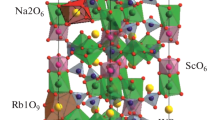Abstract
The luminescence spectra of Y2O3:Bi and Sc2O3:Bi ceramics have been investigated. The spectra have been resolved into elementary components by the Alentsev–Fock method. It has been established that the luminescence is attributed to emission centers of three types, two of which are due to the replacement of Y3+ (or Sc3+) by Bi3+ at the nodes of the crystal lattice of Y2O3 (or Sc2O3) with the point symmetry C 2 and C 3i . The emission center Bi3+ in the position C3i leads to the appearance of blue luminescence with maxima at 3.03 eV for Y2O3:Bi and at 3.05 eV for Sc2O3:Bi; this luminescence is attributed to the transition 3 P 1–1 S 0. The emission center Bi3+ in the position C 2 initiates green luminescence (which is also related to the 3 P 1–1 S 0 transition in Bi3+) with a maximum in the region of 2.40 eV in Y2O3:Bi and in the region of 2.46 eV in Sc2O3:Bi. The red luminescence band with maxima at 1.85 eV in Y2O3:Bi and at 1.95 eV in Sc2O3:Bi is related to the presence of structural defects.
Similar content being viewed by others
REFERENCES
H. Ofner, M. J. Ramsey, F. P. Netzer, et al., J. Phys. Condens. Matter, 6, No. 18, 3453–3458 (1994).
L. V. Viktorov, A. V. Kruzhalov, V. L. Petrov, et al., Inorganic Scintillation Materials, Dep. at VINITI 22.10.90, No. 5433-V90, Sverdlovsk (1990).
A. M. van de Gaats and G. Blasse, Chem. Phys. Lett., 243, Nos. 5–6, 559–563 (1995).
G. A. Gogotsi, I. A. Zakharov, A. M. Kushnirenko, and E. S. Lukin, Probl. Prochn., No. 10, 45–50 (1979).
G. A. Gogotsi, Ya. L. Grushevskii, and V. P. Zavada, Probl. Prochn., No. 4, 27–31 (1980).
I. A. Meriloo and R. V. Melenina, Tr. Inst. Fiz. Akad. Nauk ÉSSR, 39, 250–261 (1972).
Su Qiang, C. Barthou, J. P. Denis, et al., J. Luminesc., 28, 1–11 (1983).
M. V. Fok, Tr. FIAN, 59, 3–24 (1972).
A. M. Rzhevskii, N. I. Makarevich, and P. P. Mardilovich, Software System for Mathematical Processing of Optical Spectra on an "EÉlektronika DZ-28" Microcomputer, Preprint No. 513 of the Institute of Physics of the BSSR Academy of Sciences [in Russian] (1988).
N. E. Lushchik and Ch. B. Lushchik, Tr. Inst. Fiz. Astron. Akad. Nauk ÉSSR, 6, 5–62 (1957).
G. Blasse and A. Bril, J. Chem. Phys., 48, 217–222 (1968).
M. U. Bulii, S. E. Zelens'kii, V. P. Okhrimenko, and S. M. Yablochkov, Izv. Akad. Nauk SSSR, Ser. Fiz., 49, 2010–2014 (1985).
S. G. Zazubovich and V. V. Khizhnyakov, Izv. Akad. Nauk SSSR, Ser. Fiz., 49, 1874–1879 (1985).
M. J. Weber, in: Proc. Int. Workshop on Bismuth Germanate, Princeton Univ., 10–12 July (1982), pp. 3–20.
Author information
Authors and Affiliations
Rights and permissions
About this article
Cite this article
Bordun, O.M. Luminescence of Bismuth‐Activated Ceramics of Yttrium and Scandium Oxides. Journal of Applied Spectroscopy 69, 67–71 (2002). https://doi.org/10.1023/A:1015311725546
Issue Date:
DOI: https://doi.org/10.1023/A:1015311725546



